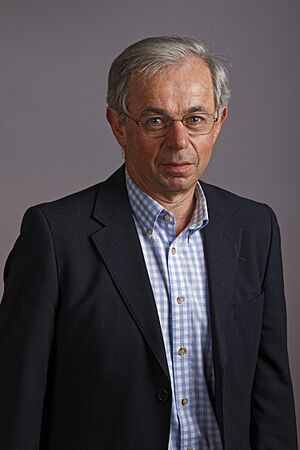David Klenerman facts for kids
Quick facts for kids
Sir David Klenerman
FRS FMedSci
|
|
|---|---|
 |
|
| Born | September 1959 (age 66) |
| Nationality | British |
| Alma mater | University of Cambridge (MA, PhD) |
| Known for | Illumina dye sequencing Scanning ion-conductance microscopy Super-resolution microscopy Solexa |
| Children | 2 (Laura & Anna) |
| Awards |
|
| Scientific career | |
| Fields | Biophysical chemistry |
| Institutions | University of Cambridge Stanford University |
| Thesis | Infrared chemiluminescence using a SISAM spectrometer (1985) |
| Doctoral advisor | Ian William Murison Smith |
| Other academic advisors | Richard Zare |
Sir David Klenerman (born in 1959) is a British scientist. He is a professor of biophysical chemistry at the University of Cambridge. He is also a Fellow at Christ's College, Cambridge.
Sir David is famous for his work on next-generation sequencing of DNA. This led to the creation of Solexa, a company he helped start. Solexa developed a very fast way to read DNA. He also worked on special microscopes. These include scanning ion-conductance microscopy and super-resolution microscopy.
Contents
Early Life and Education
David Klenerman's parents were from South Africa. He studied at the University of Cambridge. He earned his first degree, a BA, in 1982.
He continued his studies at Cambridge. In 1986, he received his PhD in chemistry. His supervisor was Ian William Murison Smith.
Career and Scientific Discoveries
After finishing his PhD, David Klenerman went to Stanford University in the United States. He was a Fulbright scholar there. He worked with scientist Richard Zare.
After his time at Stanford, he returned to the United Kingdom. He worked for BP Research for seven years. In 1994, he joined the University of Cambridge. He became a professor in the Department of Chemistry. He also became a fellow at Christ's College.
Inventing DNA Sequencing
Sir David Klenerman and Shankar Balasubramanian invented a new way to read DNA. This method is now known as Solexa sequencing or Illumina dye sequencing. It is a type of next-generation sequencing.
This method works by finding special fluorophore-labelled nucleotides. These are the building blocks of DNA. They light up as they are added to DNA strands. This "sequencing by synthesis" method became very popular.
It is now the most common way to read DNA. It replaced older methods like Sanger sequencing. This new method has many benefits:
- It is automatic.
- It is very fast.
- It is highly accurate.
- It can read many DNA strands at once.
- It is cheaper for reading an entire genome.
Exploring New Microscopy Methods
Sir David is also known for his work with special microscopes. He explored scanning ion-conductance microscopy (SICM). This method uses tiny nanopipettes instead of larger micropipettes.
His research team achieved amazing results. They created very clear 3D images of living cells. They could also deliver tiny molecules to cells precisely. This helped them study how cells work in real-time.
More recently, his team has focused on 3D super-resolution microscopy. This helps them understand protein misfolding. This is important for studying neurodegenerative diseases. These are diseases that affect the brain and nerves.
Commercial Ventures
Sir David Klenerman and Shankar Balasubramanian turned their DNA sequencing invention into a business. They started a company called Solexa in 1998. This company focused on high-speed DNA sequencing.
In 2007, a larger company called Illumina bought Solexa. The sale was for $600 million.
In 2004, Sir David also helped start another company called Ionscope. Ionscope sells scanning ion-conductance microscopes. These microscopes help researchers get high-resolution 3D images of living cells. By February 2014, Ionscope had sold 35 SICM units around the world.
Awards and Recognitions
Sir David Klenerman has received many important awards for his research:
- 2007: He received the RSC Interdisciplinary Award. This was from the Royal Society of Chemistry.
- 2012: He was chosen as a Fellow of the Royal Society (FRS). This is a great honor for scientists.
- 2015: He was elected a Fellow of the Academy of Medical Sciences (FMedSci).
- 2018: He was given the Royal Medal by the Royal Society.
- 2019: He was knighted by the Queen. This means he received the title "Sir." It was for his work in science and developing fast DNA sequencing.
- 2020: He won the Millennium Technology Prize with Professor Sir Shankar Balasubramanian. This was for their invention of Next Generation DNA Sequencing.
- 2021: He won the 2022 Breakthrough Prize in Life Sciences. He shared this with Professor Sir Shankar Balasubramanian and Pascal Mayer. It was also for their work on Next Generation DNA Sequencing.
- 2024: He received the Canada Gairdner International Award.

